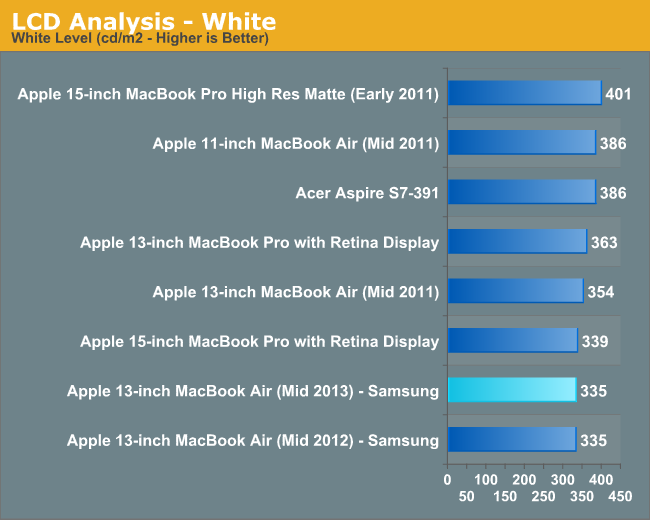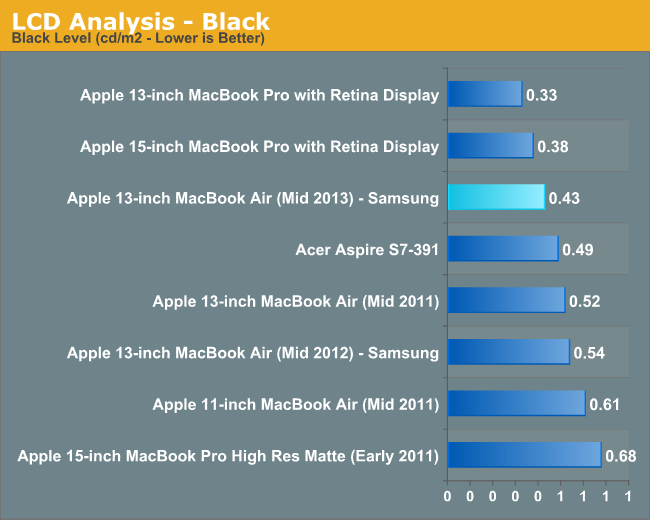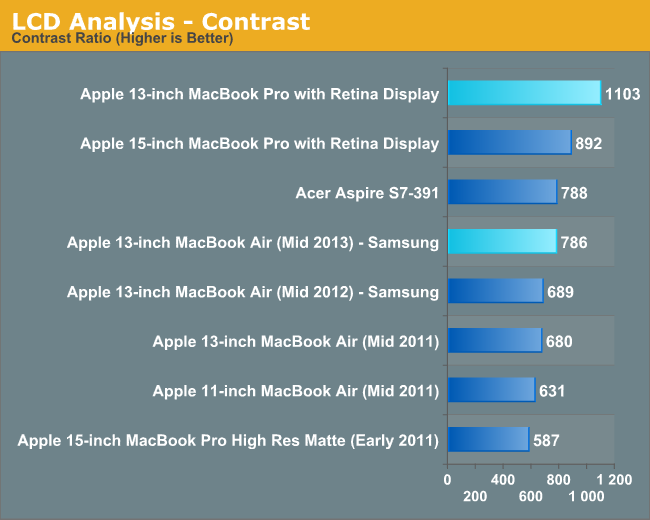The 2013 MacBook Air Review (13-inch)
by Anand Lal Shimpi on June 24, 2013 12:01 AM ESTDisplay
When I reviewed the 13-inch MacBook Pro with Retina Display, I viewed it as the true Retina MacBook Air that everyone was waiting for. With modest increases in thickness and weight, the rMBP13 gave you a much better screen and a larger battery to drive it. Apple’s lineup made sense.
After being in Taiwan earlier this month and checking out all of the 13.3-inch 2560 x 1440 displays being used on notebooks similar in size to the 13-inch MBA, I was beginning to reconsider my position.
To hit an aggressive schedule, you have to mitigate risk. In the case of the 2013 MBAs, Apple kept the chassis spec unchanged in order to do just that. As a result, the displays too, remained unchanged. We’re talking about TN panels (admittedly higher quality than most) and traditional pixel densities. Compared to the Retina Displays deployed across the rest of Apple’s product lines, these panels just aren’t as good. Compared to what you typically find elsewhere, they’re still among the best.

There are two aspects to deploying a Retina Display in a MacBook Air that are worth discussing. The first is power consumption. Greater pixel density requires a more powerful backlight to drive the panel at the same brightness, which in turn reduces battery life. Apple’s solution is to deploy Retina Displays on products it can outfit with a sufficiently large battery. I’d argue that given the battery life of the 2013 MBAs, Apple could move to a Retina Display and still deliver reasonable battery life - but it would be a regression.
The second thing to consider is price. I don’t know just how much more a Retina Display would add to the cost of a MacBook Air, but it’s clear it would be non-negligible.
There’s no real solution to the first problem, but the second one should be less of an issue as panel prices come down. I don’t know where Apple will eventually land on all of this, but today what happens is we get a well defined separation between MacBook Air and MacBook Pro with Retina Display.
Professional users who need greater color accuracy and/or additional desktop resolution really should go for the MacBook Pro with Retina Display. If you don’t need either, the MacBook Air will suffice.
In practice, the MBA’s display isn’t bad by any means. I’ve been staring at it non-stop since WWDC and don’t mind using it at all. The biggest visual issue for me is actually the shifting contrast at off-center vertical angles. It’s not a problem once you properly adjust the display angle but it’s something you don’t have to deal with on the rMBPs. When I'm not in crazy work mode, the lack of resolution isn't a huge deal - but when putting together big articles like this one, I find myself missing the rMBP quite a bit. I guess that's why the rMBP has Pro in the name.



My review sample featured a Samsung panel (LSN133BT01A02), although I’m sure the usual panel lottery is in full effect this generation as it has been in the past. Brightness and contrast are both comparable to what we had last generation (my Samsung panel this year was a bit better than last year's). The brightness/contrast results are very comparable to Acer's 1080p S7, just to show you how far Ultrabooks have come.
I ran the 2013 MBA through Chris Heinonen’s new display workflow using CalMAN to give you an idea of color accuracy vs. the rMBP:



| CalMAN Display Comparison | ||||||||
| Apple iPad (3rd gen) | Apple iPhone 5 | 13-inch rMBP (uncalibrated) | 13-inch 2013 MBA (uncalibrated) | Google Chromebook Pixel | ||||
| Grayscale 200 nits Avg dE2000 | 3.7333 | 3.564 | 1.7825 | 3.348 | 7.132 | |||
| CCT Avg (K) | 6857K | 6925K | 6632K | 6809K | 6442K | |||
| Saturation Sweep Avg dE2000 | 3.193 | 3.591 | 2.1663 | 5.3608 | 7.0927 | |||
| GMB Colorchecker Avg dE2000 | 3.0698 | 4.747 | 2.4521 | 3.9883 | 5.7664 | |||
The 13-inch MacBook Air isn’t bad, but Apple’s Retina Display is just better.













233 Comments
View All Comments
appliance5000 - Friday, December 20, 2013 - link
One word - tablets.mikeztm - Monday, June 24, 2013 - link
Could that PCIe ssd works with Filevault2 without performance down?My 2011 MBA's SSD became much slower after enabling Filevault2.
|-8-| - Monday, June 24, 2013 - link
>Five years after its introduction, the MacBook Air really has>grown into a very polished, mature platform. The 2013
>model is really the epitome of what Apple set out to
>build back in 2008, we just finally have the right hardware
>available to realize the vision. Nearly every component has
>been perfectly selected.
For a ultramobile working horse, there are still some substantial shortcomings: It's still a glossy display tying your work place to indoor use or cloudy weather. There is still no LAN, no VGA - this makes many headaches in business everyday life.
Maybe the author better leaves the marketing to Apple and concentrates on listing the Pros AND Cons of the product. It's a fine notebook, but definitely not perfect. ;)
weiran - Monday, June 24, 2013 - link
You forget not everyone works in a corporation and has your requirements, especially considering this is a consumer device first and foremost. Apple looks to the future, which may mean minor pain in the short-term (having to use adapters for LAN and VGA), but realistically do you think in 2-3 years either of those will exist on any consumer laptop?|-8-| - Monday, June 24, 2013 - link
It's not about having these or that requirements. The author is praising something to the skies, that has obvious short comings. (Every product has that.) What would be more 'neutral' verbalised: The components are perfectly selected. [...]. There are a few compromises, so the screen has good contrast, but isn't really usable outside, for example in a park. Further missing legacy ports force to carry adapters for using old legacy infrastructure like LAN networks or common LCD projectors.It's about writing a review - I don't want to read someones marketing arguments.
And by the way: Yes, VGA and LAN will be important in the future - most LCD projectors still have VGA and in contrast to HDMI or Displayport it really works reliable. I was at a conference a month ago - VGA saved me as Displayport wasn't working at all.
LAN is without alternative to share and synchronise big amounts of data.
Grennum - Monday, June 24, 2013 - link
VGA is certainly dying. By the end of the year all of the projects in our boardrooms will be replaced with Smart Screens, which you connect to via Wi-Fi. We have wired HDMI as a back-up works perfectly.Wired LAN is not dying by why would you ever have large amounts of data on your ultra portable laptop? That is just be irresponsible. If you are working with large data sets best to do it on a remote system where you have the performance, and reliability.
This laptop would perfectly meet the needs for many of our business users, maybe not engineering, but then engineering wouldn't be looking at an ultraportable (remote engineering desktops notwithstanding)
|-8-| - Monday, June 24, 2013 - link
Maybe I should switch to your company. ;) There are some new projectors here having HDMI (sadly no Displayport). But most projectors are quite old (still working), these are connected via VGA. There is some time left, till the last old projectors die.Honestly I don't see a bonus in digital alternatives. THE standard is still missing, as most notebooks have either HDMI or Displayport.
WLAN seems to have high signal latency between two computers. If you syncronise two big collections of many many subfolders and many small files in there, you notice a huge difference even between 100 MBit/s LAN and 300 MBit/s WLAN. I use WLAN for backups, but speed sucks.
Another problem is security of data in the private sector, these security guys don't like WLAN.
A5 - Monday, June 24, 2013 - link
Then maybe don't work in a park? I don't know of any laptop with a bright enough screen and good enough battery life to actually work outdoors.|-8-| - Monday, June 24, 2013 - link
Well, the Samsung Series 9 900X3C-A04DE or the Lenovo x220/x230 are two, that can be used outdoors. There should be more, some Zenbooks have also matte screens.darwinosx - Monday, June 24, 2013 - link
Well Samsung makes cheap junk that doesn't work and has no support.